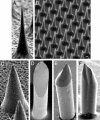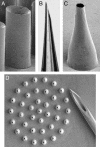Microfabricated needles for transdermal delivery of macromolecules and nanoparticles: fabrication methods and transport studies
- PMID: 14623977
- PMCID: PMC283494
- DOI: 10.1073/pnas.2331316100
Microfabricated needles for transdermal delivery of macromolecules and nanoparticles: fabrication methods and transport studies
Abstract
Arrays of micrometer-scale needles could be used to deliver drugs, proteins, and particles across skin in a minimally invasive manner. We therefore developed microfabrication techniques for silicon, metal, and biodegradable polymer microneedle arrays having solid and hollow bores with tapered and beveled tips and feature sizes from 1 to 1,000 microm. When solid microneedles were used, skin permeability was increased in vitro by orders of magnitude for macromolecules and particles up to 50 nm in radius. Intracellular delivery of molecules into viable cells was also achieved with high efficiency. Hollow microneedles permitted flow of microliter quantities into skin in vivo, including microinjection of insulin to reduce blood glucose levels in diabetic rats.
Figures





Similar articles
-
Biodegradable polymer microneedles: fabrication, mechanics and transdermal drug delivery.J Control Release. 2005 May 5;104(1):51-66. doi: 10.1016/j.jconrel.2005.02.002. Epub 2005 Apr 1. J Control Release. 2005. PMID: 15866334
-
In vitro and in vivo characterization of MEMS microneedles.Biomed Microdevices. 2005 Mar;7(1):47-52. doi: 10.1007/s10544-005-6171-y. Biomed Microdevices. 2005. PMID: 15834520
-
Microfabricated microneedles for gene and drug delivery.Annu Rev Biomed Eng. 2000;2:289-313. doi: 10.1146/annurev.bioeng.2.1.289. Annu Rev Biomed Eng. 2000. PMID: 11701514 Review.
-
Microneedles for transdermal drug delivery.Adv Drug Deliv Rev. 2004 Mar 27;56(5):581-7. doi: 10.1016/j.addr.2003.10.023. Adv Drug Deliv Rev. 2004. PMID: 15019747 Review.
-
Dissolving polymer microneedle patches for rapid and efficient transdermal delivery of insulin to diabetic rats.Acta Biomater. 2013 Nov;9(11):8952-61. doi: 10.1016/j.actbio.2013.06.029. Epub 2013 Jun 29. Acta Biomater. 2013. PMID: 23816646
Cited by
-
Skin needling to enhance depigmenting serum penetration in the treatment of melasma.Plast Surg Int. 2011;2011:158241. doi: 10.1155/2011/158241. Epub 2011 Apr 7. Plast Surg Int. 2011. PMID: 22567235 Free PMC article.
-
Microneedle-Based Natural Polysaccharide for Drug Delivery Systems (DDS): Progress and Challenges.Pharmaceuticals (Basel). 2022 Feb 3;15(2):190. doi: 10.3390/ph15020190. Pharmaceuticals (Basel). 2022. PMID: 35215302 Free PMC article. Review.
-
Biomaterial-based microstructures fabricated by two-photon polymerization microfabrication technology.RSC Adv. 2019 Oct 25;9(59):34472-34480. doi: 10.1039/c9ra05645a. eCollection 2019 Oct 23. RSC Adv. 2019. PMID: 35530014 Free PMC article. Review.
-
Silk Fibroin Microneedles for Transdermal Drug Delivery: Where Do We Stand and How Far Can We Proceed?Pharmaceutics. 2023 Jan 20;15(2):355. doi: 10.3390/pharmaceutics15020355. Pharmaceutics. 2023. PMID: 36839676 Free PMC article. Review.
-
Low-frequency low-intensity ultrasounds do not influence the survival and immune functions of cultured keratinocytes and dendritic cells.J Biomed Biotechnol. 2009;2009:193260. doi: 10.1155/2009/193260. Epub 2010 Jan 19. J Biomed Biotechnol. 2009. PMID: 20145702 Free PMC article.
References
-
- Madou, M. (1997) Fundamentals of Microfabrication (CRC, Boca Raton, FL).
-
- Chen, J. & Wise, K. D. (1997) IEEE Trans. Biomed. Eng. 44, 760–769. - PubMed
-
- Brazzle, J., Papautsky, I. & Frazier, A. B. (1999) IEEE Eng. Med. Biol. Mag. 18, 53–58. - PubMed
-
- Lin, L. & Pisano, A. P. (1999) IEEE J. Micromech. Syst. 8, 78–84.
-
- Stoeber, B. & Liepmann, D. (2000) Proc. ASME MEMS Dev. 2000 IMECE 2, 355–359.
Publication types
MeSH terms
Substances
LinkOut - more resources
Full Text Sources
Other Literature Sources

